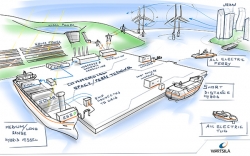Some of the New Products on Show
Whole-vessel electrification solutions
Wärtsilä
 A visit to Wärtsilä’s booth will show how the journey toward decarbonization will rely on three essential technology pillars: future fuels, efficiency and electrification. Carbon-neutral and carbon-free fuels will be at the heart of this for new-build vessels and upgrades. Wärtsilä has experience in both. However, new fuels will inevitably have a higher cost and lower power density than current fuels, so reducing the amount of fuel used will be important no matter which is selected.
A visit to Wärtsilä’s booth will show how the journey toward decarbonization will rely on three essential technology pillars: future fuels, efficiency and electrification. Carbon-neutral and carbon-free fuels will be at the heart of this for new-build vessels and upgrades. Wärtsilä has experience in both. However, new fuels will inevitably have a higher cost and lower power density than current fuels, so reducing the amount of fuel used will be important no matter which is selected.
Depending on vessel type, energy savings in the region of 5-10% can be achieved by combining ESTs and an optimized propeller. However, many newer vessels already have ESTs installed, so room for improvement is limited. For this reason, alternative ESTs such as air lubrication systems and wind rotors – also part of the Wärtsilä portfolio – will continue to gain traction.
Electrification – particularly the wider adoption of hybrid systems that incorporate batteries for energy storage – will be key to supporting marine decarbonization, due to its ability to improve energy utilization. Electrification can decouple energy production from consumption to enable engines to operate at maximum efficiency, providing instant power as needed and improving redundancy, load response and power availability.
Due to their positive impact on a vessel’s energy efficiency design index (EEDI), PTO/PTI solutions are now standard on board most new-builds. The rapidly approaching introduction of the Energy Efficiency Existing Ships Index (EEXI) is driving a huge increase in demand in the retrofit market as well.
Taking electrical power from shore instead of from the engines significantly reduces emissions and noise pollution. The two main options are alternative marine power (AMP), which allows vessels in port to turn off their gensets and take power from shore, or charging of an onboard energy storage system, usually batteries, either as a fully electric or hybrid vessel. This option can be automated with a wireless inductive charging system or an automated plug-in system, allowing zero-emission sailing.
Wärtsilä has been delivering hybrid systems since the dawn of this technology, starting with an offshore vessel in 2011. It is now a market leader in hybrid systems for new-builds and existing vessels alike.
As well as enabling immediate energy savings, hybridization is a bridge to the future. New power-production technologies such as fuel cells and engines that can run on cleaner future fuels will likely require hybrid system integration to ensure safe and stable operation, especially in transient load conditions or when connected to shore power systems.
Visitors will also discover how the Wärtsilä energy management system can integrate all these solutions and optimize them to work seamlessly together to boost efficiency and operational performance.
